Identifying Climate Adjacency for Enhancing Climate Action Using Systems Thinking and Modelling
Abstract
:1. Introduction
2. Materials and Methods
- Familiarization with project: project teams made presentations about their projects in order to familiarize us with the details of the social–ecological systems they were intervening in, their project designs, rationales and expected and achieved results;
- Introduction to systems thinking and workshop purpose: we carried out a short presentation on systems thinking and its tools to familiarize the participants with them, and also laid out the goals of the workshop;
- Understanding historical dynamics through BOTGs: Collectively, with the project teams, key indicators aligned with their work and broadly aligned with climate change (e.g., related to resources and livelihoods, such as commons, water, energy, agriculture and forests) were shortlisted. The project teams were then broken down into groups and they were asked to draw out the historical evolution of the variables in the form of BOTGs, marking the key shifts or changes in dynamics they had observed/had evidence of from the past and the reasons for the shifts. They also drew the reference modes for their ‘hope’ and ‘fear’ for the future, as is done commonly in participatory systems thinking exercises. A short demo was done to familiarize them with this tool and process of applying it;
- Presentation of BOTGs by participants: Each group then presented their BOTGs to the larger group and explained the reasoning for the shapes of change. A Q&A between the larger group and the presenting group ensued and, in many of the cases, the trends of the graphs were revised by the teams based on new information or data that someone from another group provided;
- Developing CLDs by listening to participants: As the participants presented their BOTGs and narrated the stories and reasons behind the trends and shifts in dynamics, it provided rich causal information for us as modellers to map out causal interactions that were inherent in the narratives. This led to the creation of multiple causal loop diagrams ‘live’ in the workshop settings. These were then presented to the group and verified/validated. They underwent change based on feedback and then were revised and finalized if the group thought that they were able to capture the causal logics in their landscapes adequately;
- Presentation on climate change mitigation and adaptation: We then made a presentation highlighting important trends in climate change, climate impacts and climate mitigation and adaptation to familiarize the team and bring participants onto the same page regarding climate change and climate action;
- Listing of project activities: All the main project activities of the concerned project were listed by the participants;
- Using mitigation and adaptation matrices to position project activities: Participants used 2 frameworks given to them (provided in supplementary material) to position their activities in terms of their impacts on livelihoods and the environment (relevant for adaptation) and carbon sources and sinks (relevant for mitigation). This was done in breakout groups and then finalized through group review;
- Generating systems stories capturing linkages with adaptation and mitigation: Listening to the reasoning behind the charts prepared by the participants provided information rich with causal interplays which was used to make CLDs capturing them.
3. Results
3.1. Short Note on the Notation of Causal Loop Diagrams
3.2. Systems Stories
3.2.1. Loss of Pastoral Mobility
3.2.2. Role of Mangroves for Livelihoods, Adaptive Capacity, Mitigation and Risk Reduction
3.2.3. Adaptation–Mitigation Linkages in Context of Plantations
3.2.4. Escalation in the Conservation Discourse
3.2.5. Oran-Based Livelihoods and Conservation
3.2.6. Maladaptation in Orans
3.2.7. Agriculture-Driven Maladaptation in Orans
- Weather change: Weather changes, mainly in the rainfall, have led to a reduction in agriculture productivity due to shortfall in water availability. This has created the need for either drilling borewells or moving closer to/inside the Orans (which are traditionally high-fertility zones due to rich biodiversity and water availability) for agricultural activities. As the land under Orans is reduced, it also reduces its vegetation and thereby the flow of ecosystem services. This then reduces the ability of farmers to maintain their agriculture productivity even outside of the Orans, thus creating a reinforcing loop, escalating pressure from farmers to move closer to and inside the Orans, encroaching on the land for agriculture (R2). Instances of borewells being drilled in Orans have also been found of late;
- Change in market forces: Market prices which drive the demand for crop varieties also create an additional demand on resources such as water and land and pressure on soil fertility and agriculture. In order to increase their income, farmers are incentivized to move towards farm mechanization and to expand their cropping intensity, both of which are incentives to encroach on the Orans. This effect also works towards making the reinforcing loop R2 more dominant, increasing the pressure on Orans and consequently impacting the balance between Orans and agriculture, as described before. Thus, market forces incentivizing changes in agricultural practice and crop choices also creates a simultaneous pressure for expansion and thereby encroachment of Oran land.
3.2.8. Rainforest Restoration and Wildlife and Community Coexistence
4. Discussion
4.1. Takeaways from the Process
- The process of participatory systems thinking was successful in identifying and documenting the climate adjacencies of local non-climate-focused projects;
- It was found that participants had an intuitive understanding about the climate adjacencies of their projects, and systems thinking tools helped them to crystallize and express them in the form of systems stories. Thus, the workshops provided a platform for them to formally reflect on these adjacencies and collectively identify them;
- Through the participatory process of systems thinking, the participants became aware of the similarities and differences between the mental models (assumptions) of each other on how they saw the linkages of their work with climate change. This, to some extent, facilitated individual and team learning;
- The systems stories indicated that resilience towards climate change cannot be developed in isolation. All local social–ecological systems need to factor in the non-local influences of the larger system that they are part of. Resilience has to be built not just for climate, but also for market and economic uncertainties. The interplays between local and non-local systems need to be understood and their effects need to be internalized in the project design;
- Climate change mitigation and adaptation cannot and should not be seen as separate goals. One cannot be achieved without the other. All adaptation activities should try to strive towards mitigation. Additionally, all mitigation activities should be evaluated for their impact on adaptive capacities and on the environment. Too much focus on only one of these goals can lead to maladaptation and ultimately defeat the intended climate goal;
- Identifying maladaptation in its early stages is important as it can create a path dependence for the system to evolve towards promoting maladaptive practices. There is some element of irreversibility built into social–ecological systems in the way the systems transform themselves into new cultures in context of their changed environments. Early-stage interventions must be pursued to counter maladaptation and promote proactive adaptation in order to avoid creation of this path dependence.
4.2. System Dynamics Concept Models
4.3. Developing Computable Concept Models
4.4. Insights from the Process of Converting the CLD to SFD
- Oran-based livelihoods are non-consumptive in nature, i.e., the stock of vegetation in an Oran does not deplete through Oran-based livelihoods and that livelihood income is generated, without consumptive outflow, from the vegetation stock. This is an assumption; however, it is borne out through the description in the text given earlier. This also means that the feedback from the change in the state of Orans is much faster in the case of Oran-based livelihoods as compared to industrial livelihoods;
- The extractive livelihoods (such as mining) are consumptive livelihoods, i.e., leading to an outflow from the stock of vegetation, and the income from mining is dependent on the rate of outflow. This also means that the impact of depleting/growing Oran vegetation reflects indirectly and in a much more delayed manner on extractive livelihoods, since they do not receive feedback until the Orans have depleted substantially and the outflow from the stock receives feedback from the stock;
- The Oran-conservation ‘EbA’ loop (R3) cannot indefinitely increase the Oran vegetation as it may appear from the CLD in Figure 5. This is because, as the vegetation in Orans approaches carrying capacity, B1 becomes dominant and limits the growth;
- Missing balancing loops: There are many balancing loops which might be left out in participatory CLD making—as evidenced by loops B1 and B2 explained above—and also other balancing loops which limit the outflows based on stock values. Depleting stocks will curtail outflows if outflows exceed the stock value captured in the full SFD given in the supplementary material.
4.5. Developing the Simulation Model
4.5.1. Model Parameterization
4.5.2. Key Modelling Assumptions
- Incomes from the two livelihoods in question are the central decision-making factor used by the community. Thus, as incomes from one source of livelihood increase relative to the other, this drives the motivation of people to move towards those livelihoods and vice versa. Non-income-based motivations are not considered here;
- The impact of climate extremes is to reduce the vegetation. This assumption is taken in order to test the responsiveness of the system to climatic extremes;
- The Oran vegetation loses its ability to regenerate itself once it approaches a maximum carrying capacity. Until that time, the regeneration rate is constant (although the regeneration flow is stock-dependent and will vary with the stock value).
4.6. Scenario Runs
4.6.1. Run 1: Base Run
4.6.2. Run 2: Climate Extreme Impacts
4.6.3. Run 3: Proactive Adaptation
4.6.4. Run 4: Delayed Response
4.6.5. Overall Findings from the Simulation Runs
- There could be more than one pathway for depletion of Orans:
- Loss of income from Oran-based livelihoods weakening the livelihood–conservation loop and shifting the dominance towards extractive, unit-based livelihoods;
- Increase in income from extractive, unit-based livelihoods strengthening and shifting the dominance towards extractive, unit-based livelihoods;
- Climate events that could lead to reduction in income from Oran-based livelihoods (faster), weakening the livelihood loop and shifting the dominance towards extractive, unit-based livelihoods;
- Maladaptation and resource degradation: Climate impacts can provide fertile ground for exploitative livelihoods and practices in the form of coping (maladaptation), and the likelihood of maladaptation is high in case of weakened/degraded resource systems;
- Sustainable livelihoods and climate resilience: Strengthening sustainable livelihoods which conserve their resource base over time could be an important form of proactive adaptation (EbA) to climate change;
- Importance of timely action and proactive adaptation: The importance of consensus building and timely action in face of climate change is highlighted by the difference in the outcomes seen between scenario 3 and 4;
- Boundaries of models and of mental models: The key driver of decision making in the model is income and income-based attractiveness, while other social and ecological values are not considered. If these factors are taken into account, then it could add elasticity or resilience to the shift in loop dominance. This also raises a discussion point regarding conservation. Orans have been conserved for two reasons, historically—livelihoods as well as the love, respect and/or fear of god (Orans being a form of sacred grove/space). Thus, the runs can be interpreted to hint at the importance of non-monetary incentives to preserve Orans (which are more difficult to challenge by external exploitative drivers). This is ultimately a question of what is included and excluded in the model boundary and in the boundary of mental models of people.
5. Conclusions
- Improved awareness about the climate linkages of our own actions;
- Identifying ways of countering maladaptation and enhancing proactive adaptation and mitigation;
- Collaborative networks for leveraging collective capacities.
Supplementary Materials
Author Contributions
Funding
Data Availability Statement
Acknowledgments
Conflicts of Interest
References
- IPCC. Summary for Policymakers. In Climate Change 2021: The Physical Science Basis. Contribution of Working Group I to the Sixth Assessment Report of the Intergovernmental Panel on Climate Change; Masson-Delmotte, V., Zhai, P., Pirani, A., Connors, S.L., Péan, C., Berger, S., Caud, N., Chen, Y., Goldfarb, L., Gomis, M.I., et al., Eds.; IPCC: Geneva, Switzerland, 2021; Available online: https://www.ipcc.ch/report/ar6/wg1/downloads/report/IPCC_AR6_WGI_SPM_final.pdf (accessed on 15 November 2021).
- IPCC; Fischlin, A.; Midgley, G.F.; Price, J.T.; Leemans, R.; Gopal, B.; Turley, C.; Rounsevell, M.D.A.; Dube, O.P.; Tarazona, J.; et al. 2007a: Ecosystems, their properties, goods, and services. Climate Change 2007: Impacts, Adaptation and Vulnerability. In Contribution of Working Group II to the Fourth Assessment Report of the Intergovernmental Panel on Climate Change; Parry, M.L., Canziani, O.F., Palutikof, J.P., van der Linden, P.J., Hanson, C.E., Eds.; IPCC: Geneva, Switzerland, 2007; pp. 211–272. [Google Scholar]
- IPCC; Adger, W.N.; Agrawala, S.; Mirza, M.M.Q.; Conde, C.; O’Brien, K.; Pulhin, J.; Pulwarty, R.; Smit, B.; Takahashi, K. 2007b: Assessment of adaptation practices, options, constraints and capacity. Climate Change 2007: Impacts, Adaptation and Vulnerability. In Contribution of Working Group II to the Fourth Assessment Report of the Intergovernmental Panel on Climate Change; Parry, M.L., Canziani, O.F., Palutikof, J.P., van der Linden, P.J., Hanson, C.E., Eds.; IPCC: Geneva, Switzerland, 2007; pp. 717–743. [Google Scholar]
- IPCC. Climate Change: The IPCC 1990 and 1992 Assessments. Policymaker Summary of Working Group III. Intergovernmental Panel on Climate Change IPCC. Printed in Canada. 1992. Available online: https://www.ipcc.ch/report/climate-change-the-ipcc-1990-and-1992-assessments/ (accessed on 15 November 2021).
- UNFCCC. Available online: https://unfccc.int/topics/adaptation-and-resilience/the-big-picture/what-do-adaptation-to-climate-change-and-climate-resilience-mean (accessed on 30 August 2021).
- Rooney-Varga, J.N.; Sterman, J.D.; Fracassi, E.; Franck, T.; Kapmeier, F.; Kurker, V.; Johnston, E.; Jones, A.P.; Rath, K. Combining role-play with interactive simulation to motivate informed climate action: Evidence from the World Climate simulation. PLoS ONE 2018, 13, e0202877. [Google Scholar] [CrossRef] [PubMed]
- The Royal Town Planning Institute. Place-Based Approaches to Climate Change. 2021. Available online: https://www.rtpi.org.uk/research/2021/march/place-based-approaches-to-climate-change/ (accessed on 15 November 2021).
- Sterman, J.D.; Fiddaman, T.; Franck, T.; Jones, A.; McCauley, S.; Rice, P.; Sawin, E.; Siegel, L. Management Flight Simulators to Support Climate Negotiations. Environ. Model. Softw. 2013, 44, 122–135. [Google Scholar] [CrossRef]
- Langsdale, S.M.; Beall, A.; Carmichael, J.; Cohen, S.J.; Forster, C.B.; Neale, T. Exploring the Implications of Climate Change on Water Resources through Participatory Modeling: Case Study of the Okanagan Basin, British Columbia. J. Water Resour. Plan. Manag. 2009, 135, 373–381. [Google Scholar] [CrossRef]
- DESTA Research LLP. Banni in a Time of Change: Interactive Simulations for Systemic Engagement; DESTA Research LLP: New Delhi, India, 2021; Available online: https://www.desta.co.in/wp-content/uploads/2021/07/Brief-on-Banni-App-1.pdf (accessed on 15 November 2021).
- Carnohan, S.A.; Clifford-Holmes, J.K.; Retief, H.; McKnight, U.S.; Pollard, S. Climate change adaptation in rural South Africa: Using stakeholder narratives to build system dynamics models in data-scarce environments. J. Simul. 2021, 15, 5–22. [Google Scholar] [CrossRef]
- Mathur, M.; Sharma, K. Identifying Climate Adjacency: Key Findings from Four Case Studies and a Synthesis, Report by DESTA Research & Rohini Nilekani Philanthropies, India, January 2021. Available online: https://rohininilekani.org/identifying-climate-adjacency-key-findings-from-four-case-studies-and-a-synthesis/ (accessed on 15 November 2021).
- Sterman, J. Business Dynamics: Systems Thinking and Modeling for a Complex World; Sterman, J.D., Ed.; McGraw-Hill Higher Education: New York, NY, USA, 2000; ISBN 0-07-231135-5. [Google Scholar]
- Ford, A. Modeling the Environment, 2nd ed.; Island Press: Washington, DC, USA, 2010. [Google Scholar]
- Bharwada, C.; Mahajan, V. Let it be Banni: Understanding and Sustaining Pastoral Livelihoods of Banni. In CESS Monograph; CESS: Hyderabad, India, 2012. [Google Scholar]
- Overseas Development Institute. Pastoralism and Climate Change: Synthesis Paper. 2009. Available online: https://cdn.odi.org/media/documents/4317.pdf (accessed on 15 November 2021).
- Rahman, A.P. Swimming Camels, Mangrove Islands of Kutch Face mounting Challenges. Mongabay. 2019. Available online: https://india.mongabay.com/2019/01/swimming-camels-mangrove-islands-of-kutch-face-mounting-challenges/ (accessed on 15 November 2021).
- Agarwal, M. NGT Comes to the Aid of Kharai Camels and Mangroves in Kachchh. Mongabay. Available online: https://india.mongabay.com/2019/09/ngt-comes-to-the-aid-of-kharai-camels-and-mangroves-in-kachchh/ (accessed on 15 November 2021).
- Kibria, G. Mangrove Forests-Its Role in Livelihoods, Carbon Sinks and Disaster Mitigation. 2013. Available online: https://www.researchgate.net/publication/261178318_Mangrove_Forests-_Its_Role_in_Livelihoods_Carbon_Sinks_and_Disaster_Mitigation?channel=doi&linkId=004635337e178644a8000000&showFulltext=true (accessed on 15 November 2021).
- Chapman, S. Mangroves Protect Coastlines, Store Carbon–And Are Expanding with Climate Change. The Conversation. Available online: https://theconversation.com/mangroves-protect-coastlines-store-carbon-and-are-expanding-with-climate-change-81445 (accessed on 15 November 2021).
- Systems Archetypes I: Diagnosing Systemic Issues and Designing High-Leverage Interventions by Daniel H. Kim. The Systems Thinker. Available online: https://thesystemsthinker.com/wp-content/uploads/2016/03/Systems-Archetypes-I-TRSA01_pk.pdf (accessed on 15 November 2021).
- Chhingani, A.K. History of Common Property Resources in the Thar Desert. MGS University, Bikaner. 2020. Available online: https://mgsubikaner.ac.in/wp-content/uploads/2020/10/Common-Property-Resources-in-the-Thar-Desert.pdf (accessed on 15 November 2021).
- Gadi, B.R. Oran: A Traditional System for Conservation of biodiversity in the Thar Desert. Int. Educ. Res. J. 2016, 2, 34–35. [Google Scholar]
- Singh, A.; Bahl, R. Oran Land Issues: A Livelihood Concern for Pastoralists in Rajasthan (31 December 2006). Available online: https://ssrn.com/abstract=981506 (accessed on 15 November 2021).
- Singh, A. ‘Oran’ Sustainable Livelihood & Biodiversity Conservation System in Rajasthan. KRAPAVIS. Available online: https://www.google.com/url?sa=t&rct=j&q=&esrc=s&source=web&cd=&ved=2ahUKEwjngvTNnd3yAhUijOYKHUwOC5gQFnoECAIQAQ&url=https%3A%2F%2Fwww.globalgiving.org%2Fpfil%2F1116%2Fprojdoc.doc&usg=AOvVaw21B8-UHMlyFSf8spJSX_e- (accessed on 15 November 2021).
- Krishna, N. Orans of Rajasthan. Heritage Online. Available online: http://www.heritageonline.in/natural-heritage-discussion-3/ (accessed on 15 November 2021).
- Colls, A.; Ash, N.; Ikkala, N. Ecosystem-Based Adaptation: A Natural Response to Climate Change; IUCN: Gland, Switzerland, 2009; p. 16. [Google Scholar]
- Osuri, A.M.; Gopal, A.; Shankar Raman, T.R.; Defries, R.; Cook-Patton, S.C.; Naeem, S. Greater stability of carbon capture in species-rich natural forests compared to species-poor plantations. Environ. Res. Lett. 2019, 15, 034011. Available online: https://iopscience.iop.org/article/10.1088/1748-9326/ab5f75 (accessed on 15 November 2021).
- Richardson, G.P. Problems with causal-loop diagrams. Syst. Dyn. Rev. 1986, 2, 158–170. [Google Scholar] [CrossRef]
- Richardson, G.P. Problems with causal-loop diagrams revisited. Syst. Dyn. Rev. 1997, 13, 247–252. [Google Scholar] [CrossRef]
- Fiddaman, T. Meta SD, Loopy. 2017. Available online: https://metasd.com/2017/03/loopy/ (accessed on 15 November 2021).
- Saeed, K. Representing feedback in a computable stock/flow model. In Proceedings of the International System Dynamics Conference, Chicago, IL, USA, 25–29 July 2021. [Google Scholar]
- Fiddaman, T. Meta SD, The Ambiguity of Causal Loop Diagrams and Archetypes. 2017. Available online: https://metasd.com/2017/04/the-ambiguity-of-causal-loop-diagrams-and-archetypes/ (accessed on 15 November 2021).
- Chichakly, K.J.; (Isee Systems Inc., Lebanon, NH, USA). Personal Communication at International System Dynamics Conference, 2021.
- Ghaffarzadegan, N.; Lyneis, J.; Richardson, G.P. How Small System Dynamics Models Can Help the Public Policy Process. Syst. Dyn. Rev. 2010, 27, 22–44. [Google Scholar] [CrossRef] [Green Version]
- Homer, J. How to Right-Size Your Model. 2019. Available online: https://systemdynamics.org/how-to-right-size-your-model/ (accessed on 31 August 2021).
- Repenning, N.P. Selling system dynamics to (other) social scientists. Syst. Dyn. Rev. 2003, 19, 303–327. [Google Scholar] [CrossRef]
- Kim, D. Success to the Successful: Self-Fulfilling Prophecies. The Systems Thinker. Available online: https://thesystemsthinker.com/success-to-the-successful-self-fulfilling-prophecies/ (accessed on 15 November 2021).
| 1 | Where the community, either collectively or individually, or any other agency uses ecosystem services for their living and/or livelihood in a manner that does not conserve the ecosystem’s ability to continue to provide such services. |
| 2 | Where the community, either collectively or individually, or any other agency uses local ecosystem services for their living and/or livelihood in a manner that conserves the ecosystem’s ability to continue to provide such services, also referred to as ‘nature-based solutions’. |
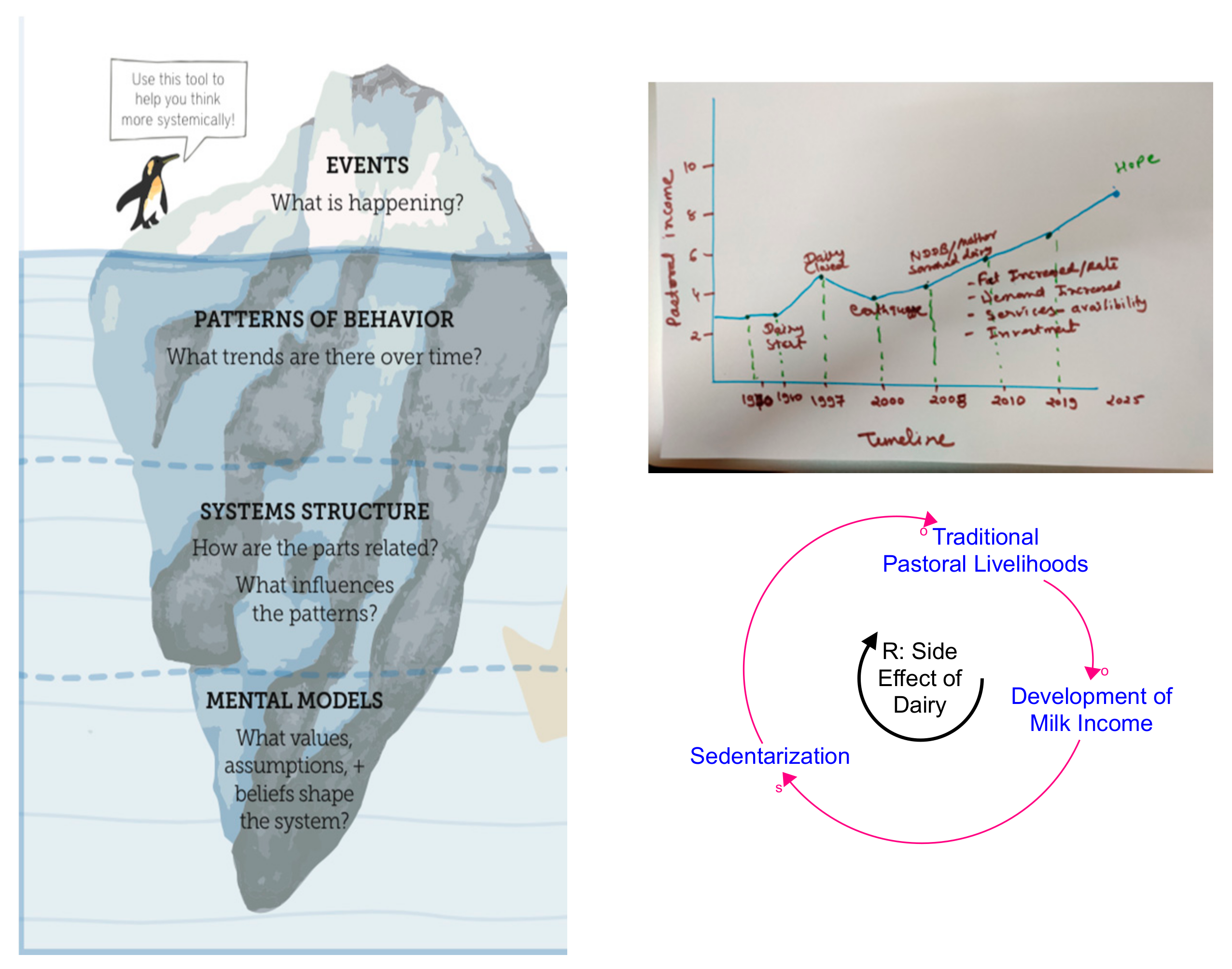



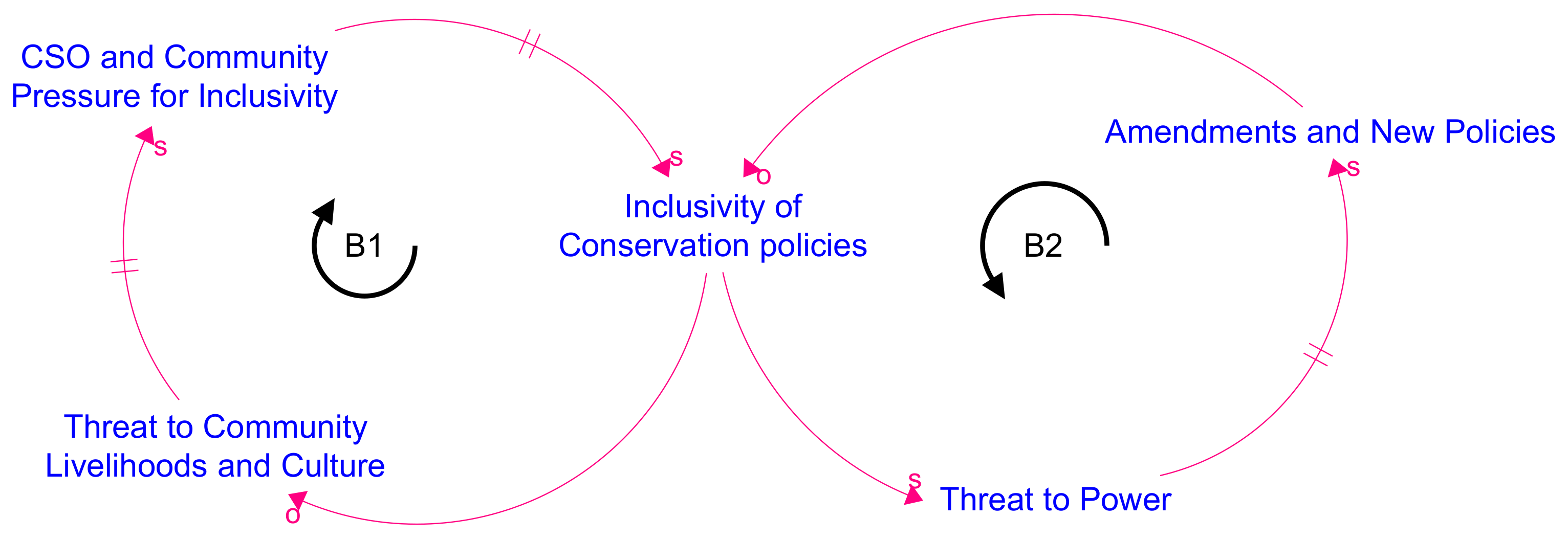


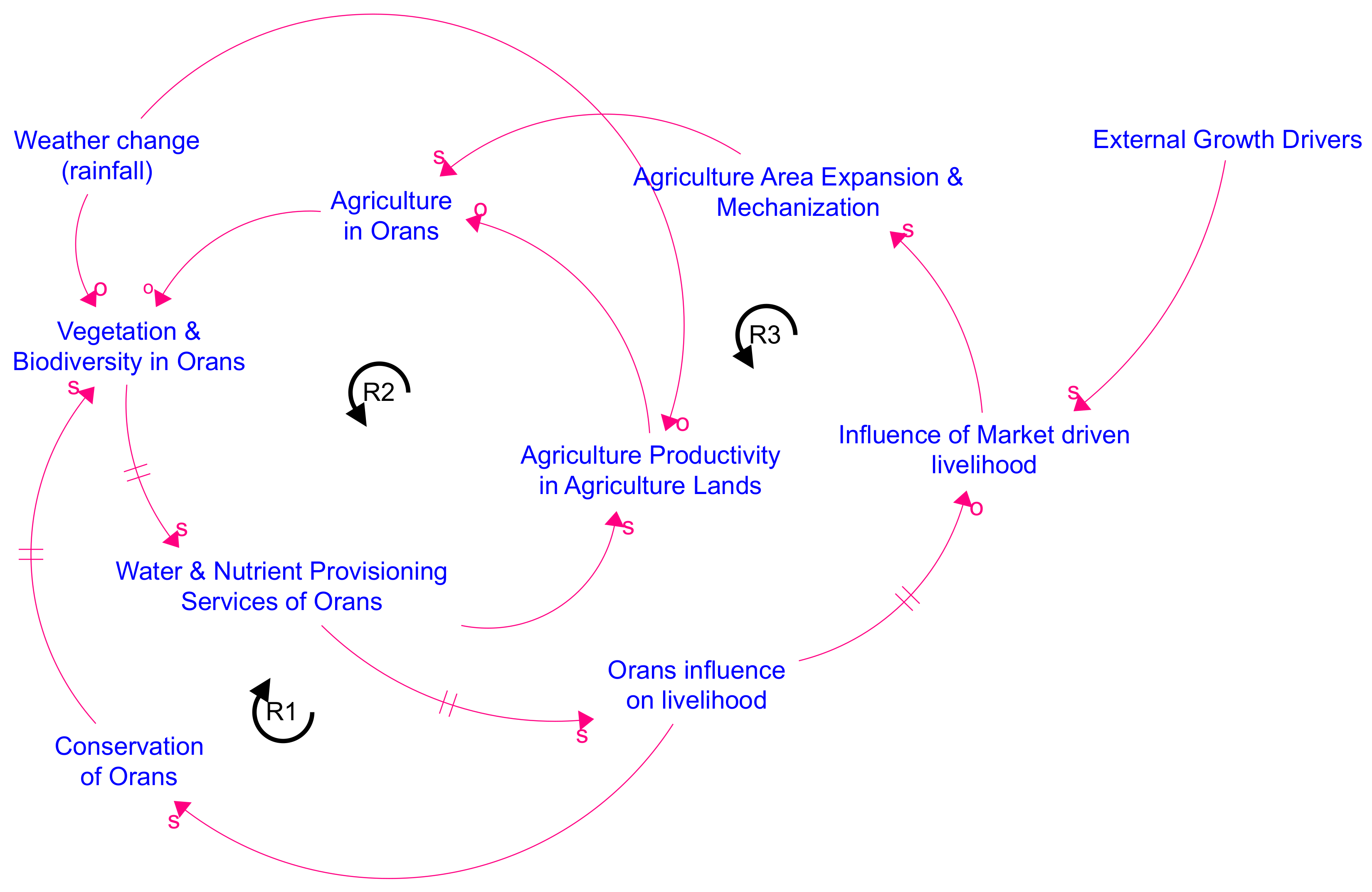
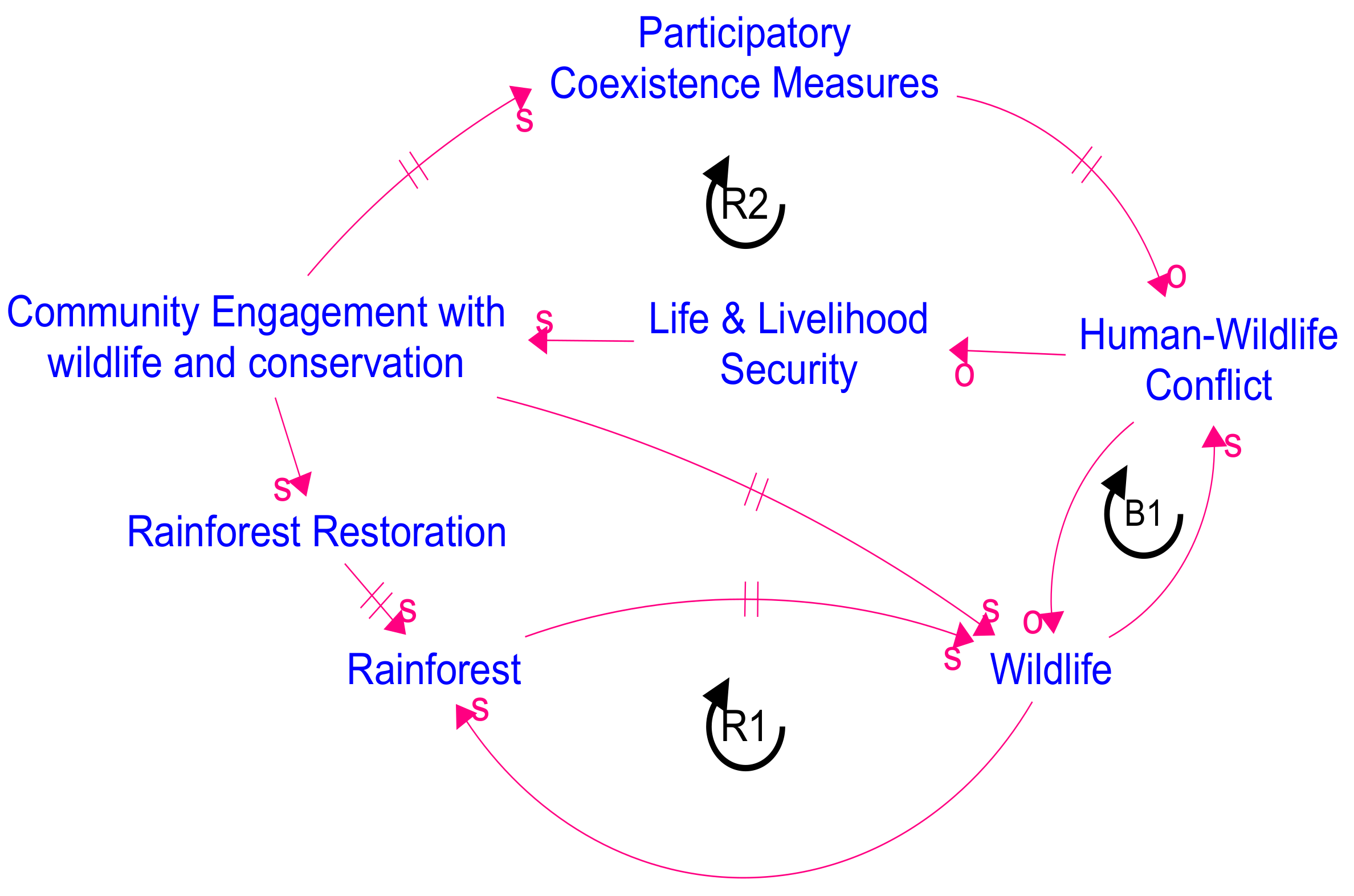
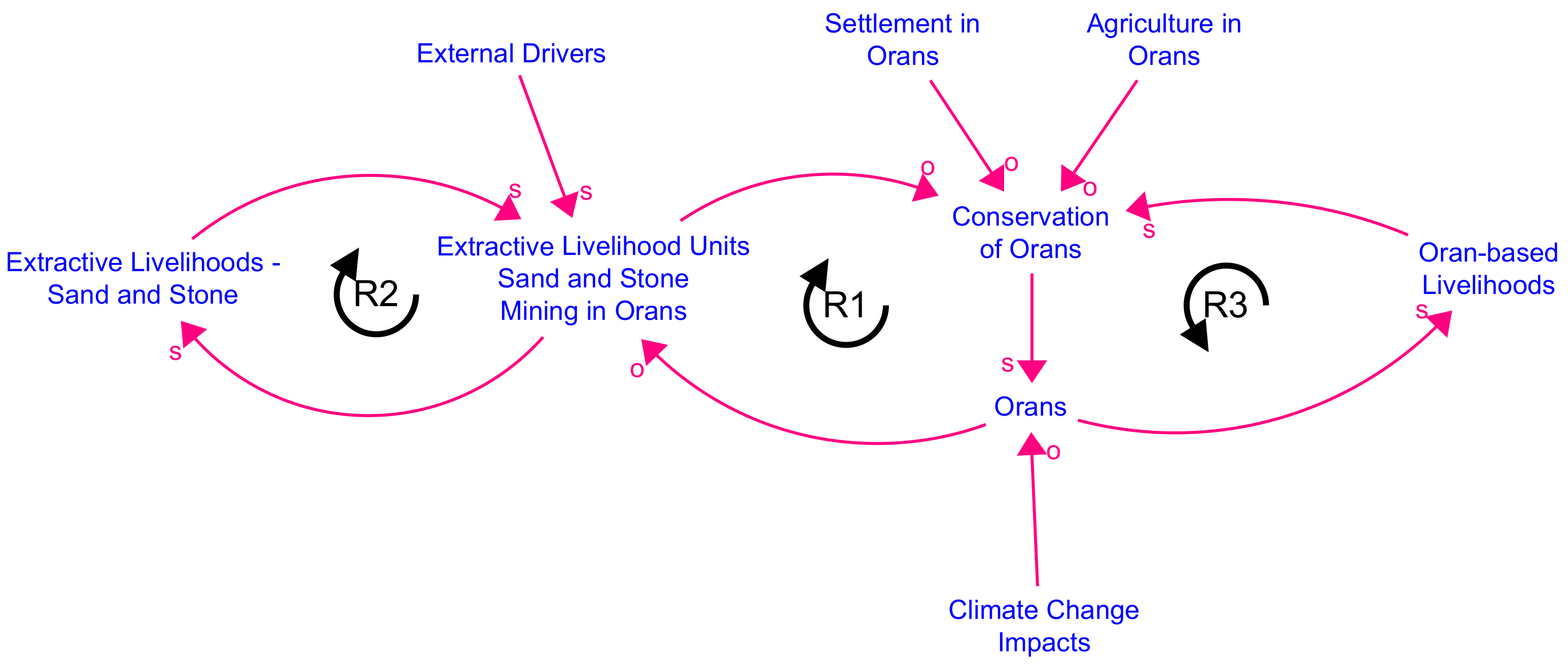

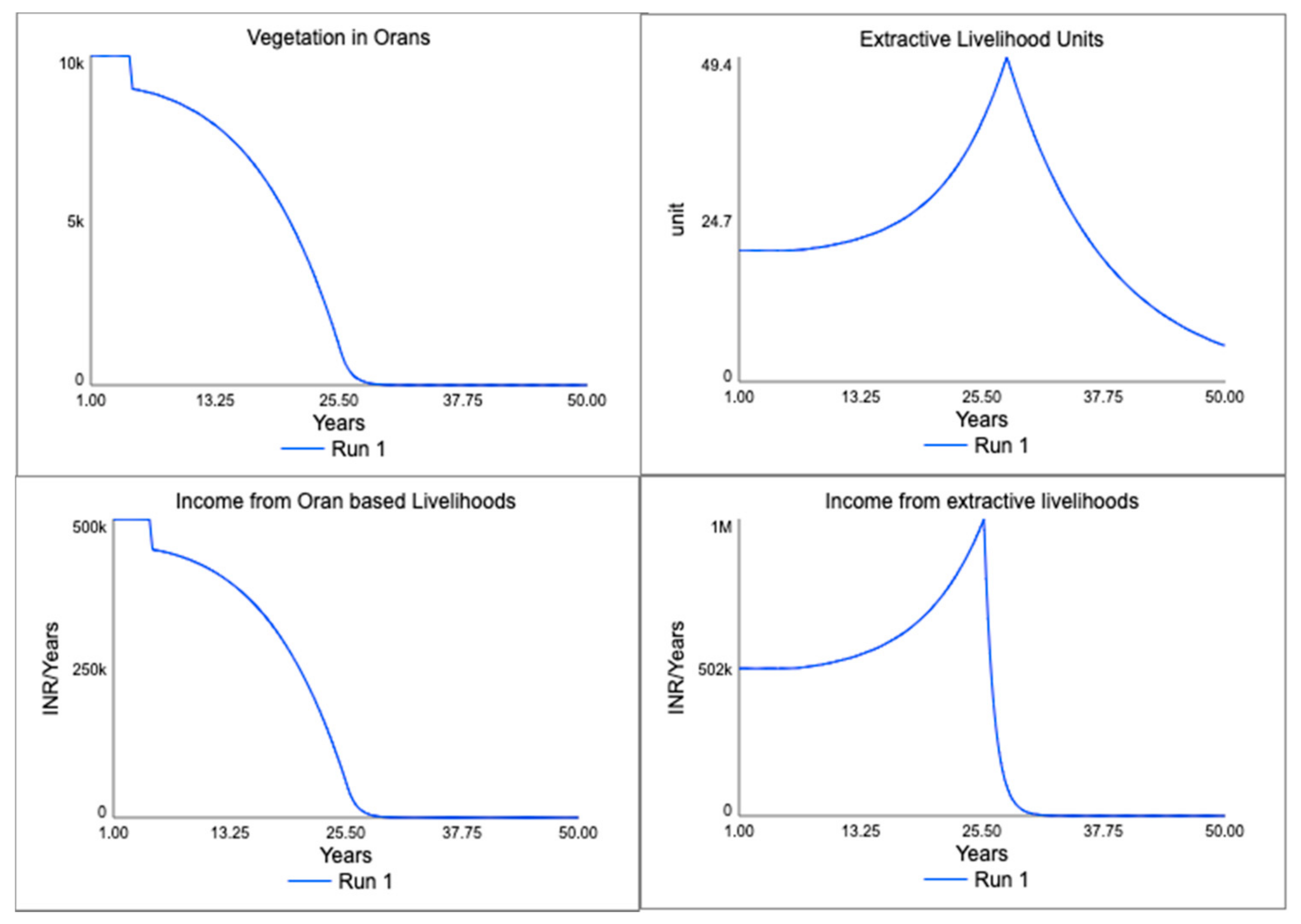

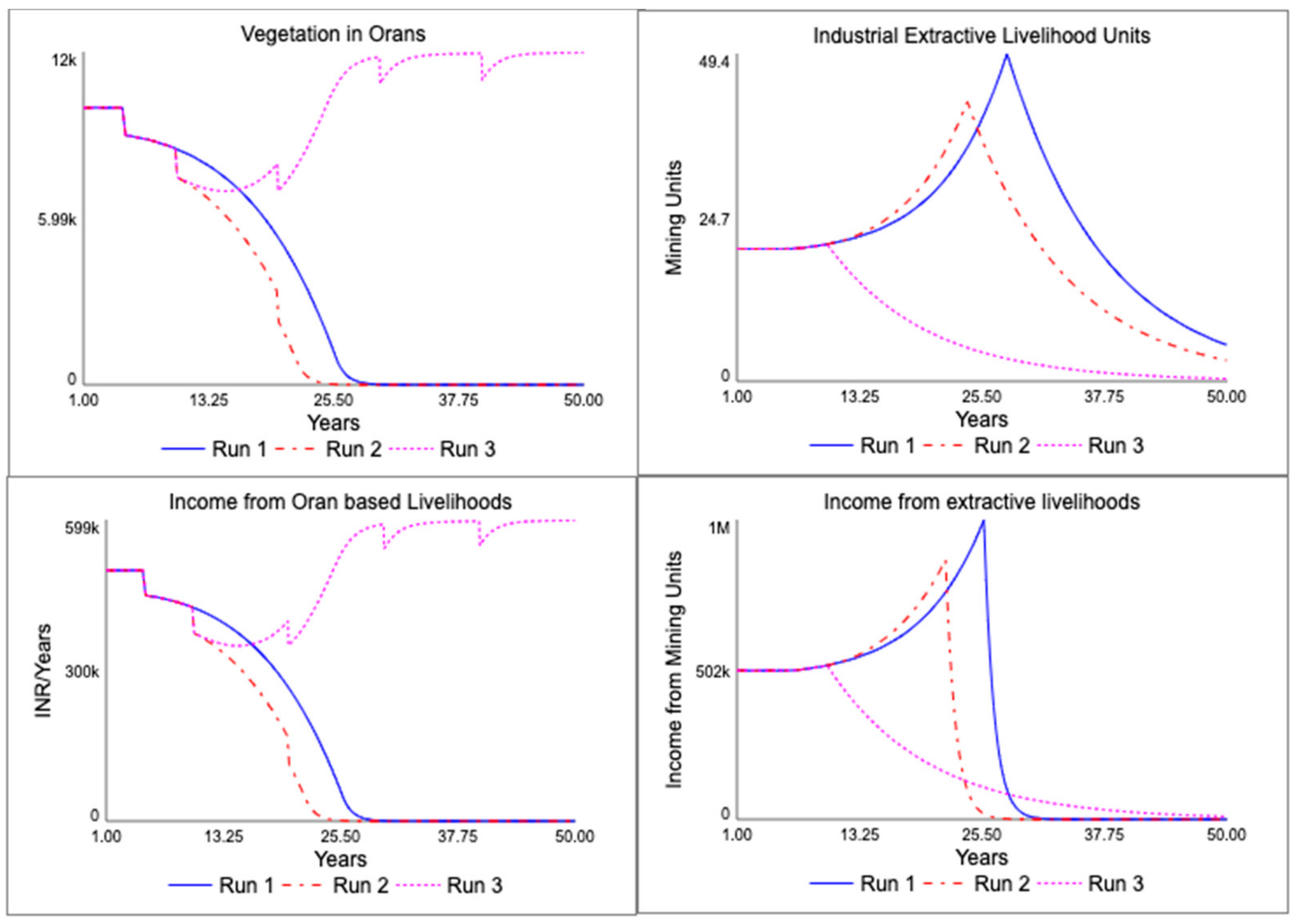

Publisher’s Note: MDPI stays neutral with regard to jurisdictional claims in published maps and institutional affiliations. |
© 2021 by the authors. Licensee MDPI, Basel, Switzerland. This article is an open access article distributed under the terms and conditions of the Creative Commons Attribution (CC BY) license (https://creativecommons.org/licenses/by/4.0/).
Share and Cite
Sharma, K.; Mathur, M. Identifying Climate Adjacency for Enhancing Climate Action Using Systems Thinking and Modelling. Systems 2021, 9, 83. https://doi.org/10.3390/systems9040083
Sharma K, Mathur M. Identifying Climate Adjacency for Enhancing Climate Action Using Systems Thinking and Modelling. Systems. 2021; 9(4):83. https://doi.org/10.3390/systems9040083
Chicago/Turabian StyleSharma, Kabir, and Mihir Mathur. 2021. "Identifying Climate Adjacency for Enhancing Climate Action Using Systems Thinking and Modelling" Systems 9, no. 4: 83. https://doi.org/10.3390/systems9040083





